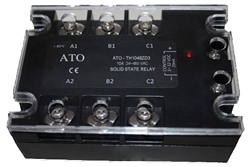What is the Solid State Relay Used for?
The dedicated solid state relay has the functions of short circuit protection, overload protection and overheat protection. It can realize the intelligent module required by the user and directly use it in the control system with the combination logic curing package.
What is the Solid State Relay Used for?
Voltage regulation
 SSR can use external analog signal to trigger the module to achieve linearly adjustable output voltage. For example, PLC or temperature controller output analog signal: 1-5V, 4-20mA trigger system. The single-phase, three-phase thyristor trigger board, with the thyristor, can also be equipped with an external analog signal to adjust the trigger board, and the trigger board can trigger the module to achieve linearly adjustable output voltage and control the conduction angle of the thyristor in order to achieve the purpose of pressure regulation.
SSR can use external analog signal to trigger the module to achieve linearly adjustable output voltage. For example, PLC or temperature controller output analog signal: 1-5V, 4-20mA trigger system. The single-phase, three-phase thyristor trigger board, with the thyristor, can also be equipped with an external analog signal to adjust the trigger board, and the trigger board can trigger the module to achieve linearly adjustable output voltage and control the conduction angle of the thyristor in order to achieve the purpose of pressure regulation.
AC power regulation
AC power regulation is a commonly used method for Z-type SSR, and it can also realize PID regulation. That is to say, in a fixed period, the number of half-waves of AC sinusoidal current is controlled to achieve the purpose of power regulation. The analog circuit often uses a voltage comparator, which compares the sawtooth voltage of a fixed period with the error voltage from the previous stage, and outputs a square wave for adjustment. The timing algorithm is used on the computer to generate square wave pulses with adjustable duty cycle.
Control three-phase motor
The dedicated solid state relay can be directly used in the control of three-phase motors. 2 solid state relays are used for motor on-off control, 4 solid state relays are used for motor commutation control, and the third phase is not controlled.
As a motor commutation, it should be noted that due to the motion inertia of the motor, the commutation must be performed after the motor is stopped, so as to avoid the large impact voltage and current caused by a situation similar to the motor stall. In the design of the control circuit, it should be noted that the possibility that the commutation SSRs are turned on at the same time should not occur at any time. For the power-on and power-on sequence, the power supply of the control circuit should be added first, then the power supply of the control circuit should be cut off, and then the power supply of the motor should be cut off first. Between the commutation SSRs, the inverter connection method cannot be simply used to avoid the interphase short circuit accident caused by the conduction of the SSR of the other phase when the SSR that is turned on is not turned off. In addition, the fuse, phase loss and temperature relay in the motor control are also protection devices to ensure the normal operation of the system.

